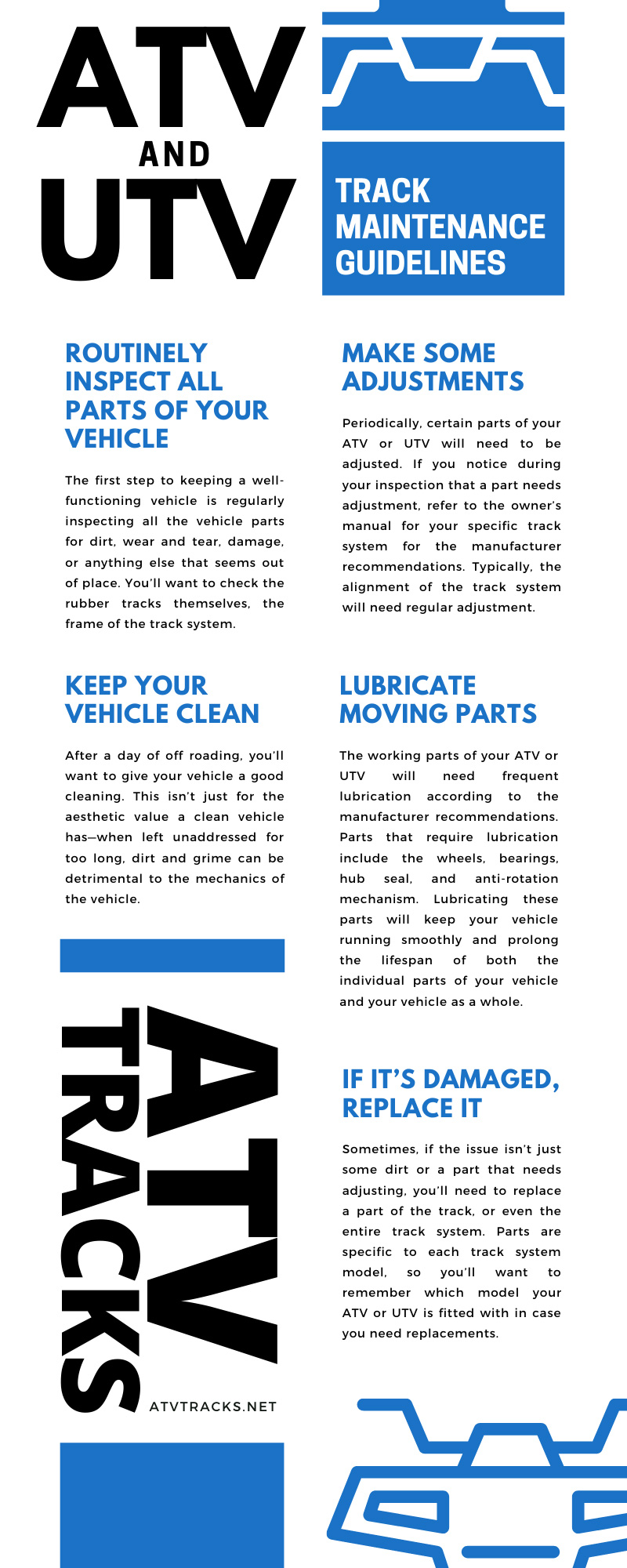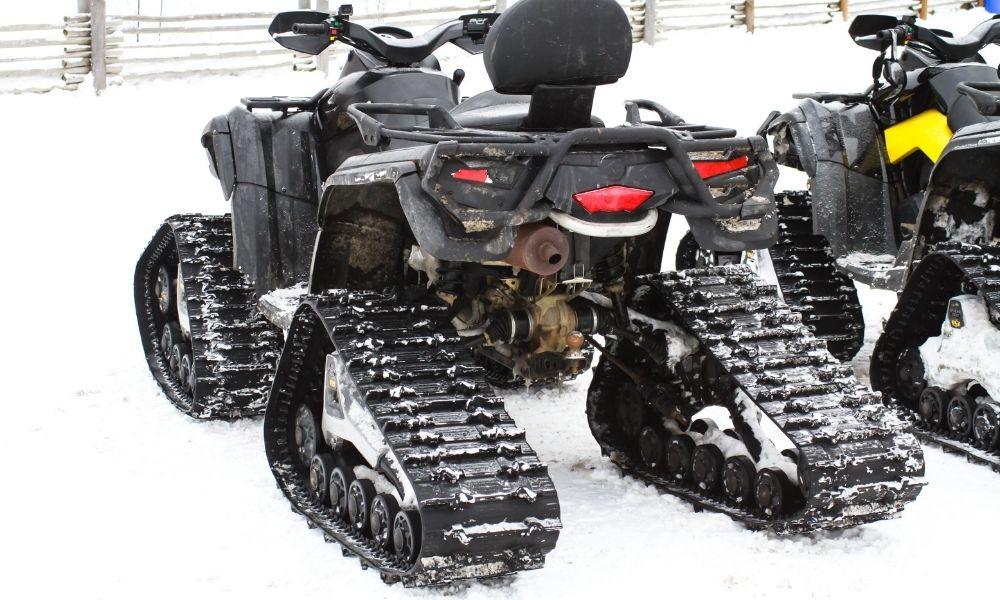Just like any other vehicle, maintenance for ATVs and UTVs is important to keep them running well. The tracks of your four-wheeler enables it to move, and so upkeep of the tracks is particularly important to consider. Tracks are often used in conditions where the ground is too soft or slippery for wheels, such as snow, mud, or sand. Due to these outdoor conditions and use in intense outdoor settings, four-wheeler tracks can easily become dirty or worn. By following the basic ATV and UTV track maintenance guidelines, you’ll be able to ensure they stay in good condition.
Parts of ATV and UTV Track Systems
It’d be hard to follow the ATV and UTV track maintenance guidelines and keep your tracks in good repair without having a basic understanding of each of the track system’s major parts. Knowing what each part does and the upkeep each part requires will help you know what to expect in terms of adjustments and repairs. This will save you time and money in the course of your ATV or UTV ownership. Below is an overview of the components of an ATV or UTV track system.
Rubber Tracks
Rubber tracks are the treaded, rubber parts that pass over the frame of the track system. The track is the part of the system that contacts the ground and allows the vehicle to move. They replace wheels and are generally longer and wider, providing the vehicle with more surface area on the ground and a better footing in rugged or slippery terrains. Track systems differ mainly based on their types of tread, and several different kinds of tracks are available, including four wheeler snow tracks and tracks designed for mud or solid ground. As the part of the track system that touches the ground, rubber tracks are particularly prone to wear, so track tension will need to be checked periodically.
Track Frame
The track frame is the skeleton of the track system which connects all the other parts together. A good track frame will be lightweight, strong, and be angled upward at the front to allow for better movement through snow and mud. The frame doesn’t require too much maintenance, but the hub bearings, hub bearing seals, and stabilizers will need to be checked and either lubricated or replaced when necessary.
Wheels
There are two types of wheels on an ATV or UTV track: drive wheels and idler wheels. The drive wheel is connected to the wheel hub of the vehicle and allows the rubber track to move. The idler wheels, located along the bottom of the track system, don’t directly control movement but contribute to the track’s movement. Both wheels and bearings must be checked for side wear. The wheel seals will need to be lubricated regularly to keep the wheels running smoothly.
Anti-Rotation Mechanism
The anti-rotation mechanism contributes to stabilizing the vehicle and making your ride smooth. This mechanism is designed to absorbs bumps, prolong the life of the vehicle, and make your ride more comfortable. The arms of the anti-rotation mechanism will need frequent lubrication, bolts will occasionally need to be adjusted, and dampeners may need to be replaced.
Five Key Points for ATV and UTV Maintenance
From simply checking over your ATV or UTV to making repairs, there are several steps to follow to keep your vehicle running well. This set of five main guidelines is a good one to follow when performing upkeep on your vehicle.
Routinely Inspect All Parts of Your Vehicle
The first step to keeping a well-functioning vehicle is regularly inspecting all the vehicle parts for dirt, wear and tear, damage, or anything else that seems out of place. You’ll want to check the rubber tracks themselves, the frame of the track system, and any wheels or other moving parts within the system.
Keep Your Vehicle Clean
After a day of off roading, you’ll want to give your vehicle a good cleaning. This isn’t just for the aesthetic value a clean vehicle has—when left unaddressed for too long, dirt and grime can be detrimental to the mechanics of the vehicle. A number of cleaning supplies are available for this purpose, with different types of cleaners corelating to different parts. First, use a basic cleaner to clear major parts of the vehicle of dirt. Then tend to the mechanics with a degreaser and finish the job by rinsing the entire vehicle with water. After washing, dry the vehicle and polish if necessary.
Make Some Adjustments
Periodically, certain parts of your ATV or UTV will need to be adjusted. If you notice during your inspection that a part needs adjustment, refer to the owner’s manual for your specific track system for the manufacturer recommendations. Typically, the alignment of the track system will need regular adjustment.
Lubricate Moving Parts
The working parts of your ATV or UTV will need frequent lubrication according to the manufacturer recommendations. Parts that require lubrication include the wheels, bearings, hub seal, and anti-rotation mechanism. Lubricating these parts will keep your vehicle running smoothly and prolong the lifespan of both the individual parts of your vehicle and your vehicle as a whole.
If It’s Damaged, Replace It
Sometimes, if the issue isn’t just some dirt or a part that needs adjusting, you’ll need to replace a part of the track, or even the entire track system. Parts are specific to each track system model, so you’ll want to remember which model your ATV or UTV is fitted with in case you need replacements.
As a rule, it’s always a good idea to keep up with the basic maintenance of your ATV or UTV tracks regularly to stave off damage and high, unexpected repair costs. Maintaining your vehicle is as easy as giving it a quick check-over and cleaning after you take it out for a ride, then lubricating moving parts and making necessary adjustments or replacements to small parts before they create bigger issues. So, remember to keep those track systems well maintained, and don’t be afraid to go take tracks out for a spin.







